Simple Linear Regression
Definition
Often we want to find a relationship between two variables to:
- Predict behavior
- Explore relationships
The simplest way to achieve this is to assume a linear relationship
Assumptions:
- Predictors are independent (not correlated)
- Residuals form a gaussian/normal distribution (bell curve)
On a qq-plot, that means they should form a straight line, for a histogram it means we should see a normal (bell) curve.
# plot qq-plot
statsmodels.api.qqplot(model.resid)
print(model.resid)
# plot histogram
fig = plt.figure(figsize=[8, 8])
ax = fig.add_subplot(1, 1, 1)
ax.hist(model.resid, 20)
offset + coefficient x variable
Minimize the Error
Try my best to estimate and given a set of observations, and , so they can give the best given
In practice, our data is rarely on a straight line

Point in our regression line is given by
is the predicted value, is the ground truth (observed) value. The difference between and is called the error (residual) ~ . We assume the residual is normally distributed around 0
The goal is to find the values of and that minimize the sum of the square of the errors

Minimum requirement: the number of training samples should be much larger than the number of terms we are trying to estimate.
Correlation
Definition: It describes the degree (ranges from -1 ~ 1) that two variables move in coordination with one another. If two variables move in the same direction, then those variables are said to have a positive correlation. If they move in opposite directions, then they have a negative correlation. It controls the strength and direction of the relationship.
We can quantify the strength of the relationship with correlation. The sign (+/-) represents the direction of the relationship.
- -1, as one value increases the other decreases
- 0, no linear relationship, statically independent. It can still have other types of relationship.
- +1, increase and decrease together




When the relationship cannot be represented with a straight line (linear relationship), correlation = 0.

The correlation of a horizontal line is undefined. Because the variance is undefined or 0.
video sources:
- Covariance - a computational step stone for calculating correlation.
- Correlation
covariance
Why Do We Care?
- If there is a linear relationship, we want to make sure the
xis correlated with the resulty. - Want our predictors to be uncorrelated with each other, since each predictor models a different aspect of the overall relationship. If they are correlated, we can end up with redundancy in the model.